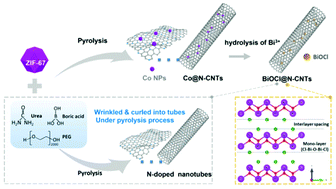Encapsulation of BiOCl nanoparticles in N-doped carbon nanotubes as a highly efficient anode for potassium ion batteries†
Abstract
With gradually increasing cost and shrinking crustal abundance for lithium ion batteries (LIBs), it is necessary to develop potassium ion batteries (PIBs) and explore suitable electrode materials for advanced PIBs. In this work, nanoscale BiOCl nanoparticles encapsulated in N-doped carbon nanotubes (BiOCl@N-CNTs) are designed and used as the anode material for K ion storage. The BiOCl@N-CNT composite is composed of BiOCl nanoparticles (≈ 5 nm) and N-doped carbon nanotubes. The ultralsmall BiOCl nanoparticles offer excellent electrochemical activity for K ion storage and short ion diffusion path for rapid reaction kinetics, while the outer layer of N-CNTs can effectively improve the conductivity and provide space to accommodate volume expansion. Due to this synergistic effect of small size and a highly conductive skeleton, the BiOCl@N-CNT composite delivers good rate capability and long-term cycling stability when evaluated as an anode for PIBs. The special structure of embedding ultrasmall active materials with high performance in highly conductive N-CNTs represents an effective way of improving the activity of the electrode material, facilitating ion/charge transfer, and alleviating volume change towards excellent energy storage technology.



 Please wait while we load your content...
Please wait while we load your content...